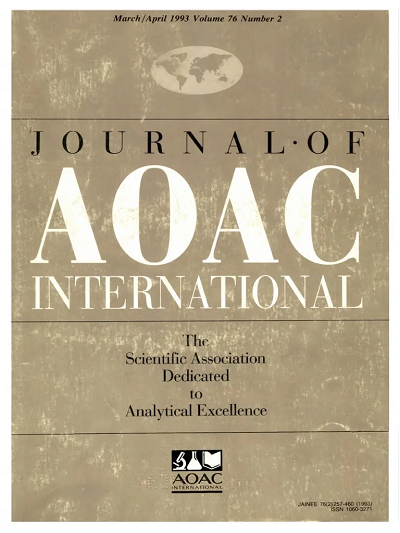选择性富集储存温度和持续时间对检测食品中沙门氏菌的影响
IF 1.7
4区 农林科学
Q3 CHEMISTRY, ANALYTICAL
引用次数: 0
摘要
背景 在检测食品中的病原体时,有时样品经选择性富集后不能立即处理,或需要在几天或几周后重新检测,以进行确认或复检。本研究旨在探讨在 4 ± 2 ℃ 和室温(20-22 ℃)下长时间储存不同选择性富集食品对检测和分离沙门氏菌的影响。方法 这项研究包括两项实验,涉及 34 种食品,比较 4 ± 2 ℃ 和室温储存对 204 种选择性富集物[拉帕波特-瓦西里阿迪斯肉汤(RV)和四硫酸盐肉汤(TT)]在 42 天储存期(实验 I)中检测沙门氏菌的影响;以及监测沙门氏菌在 300 个选择性富集样品(RV 和 TT)中的存活率,这些样品在 4 °C 下储存 60 天,富集前使用不同的肉汤[乳糖肉汤(LB)或缓冲蛋白胨水肉汤(BPW)](实验 II)。所有样品均按照 FDA BAM 方法进行沙门氏菌分析。结果 在多次取样过程中,不论沙门氏菌血清型、储存温度、富集前肉汤或选择性富集肉汤如何,沙门氏菌的阳性检出率在选择性富集后的第 42 天保持一致。然而,在实验 II 的第 60 天采样中,有 7 个之前呈阳性的结果变成了阴性。这些数据表明,在选择性富集后,将 RV 和 TT 富集物在 4 ± 2 ° C 或室温下储存长达 42 天,不会影响所检测食品类别中沙门氏菌的检测,而与沙门氏菌血清型以及用于预富集和选择性富集的肉汤无关。结论 至少对于本实验中研究的特定食物种类,如果需要,可将选择性富集沙门氏菌的回收时间推迟一段有限的时间(例如,< 42 天),而不会对检测结果产生不利影响。不过,延迟分析 TT 和 RV 富集物确实会带来检测灵敏度降低的风险,第 60 天的 7 个阴性结果与之前的阳性结果相比就是证明。我们不建议或赞成延迟分析 TT 和 RV 富集物。要点 在本实验所调查的食物基质中,如有必要,可推迟一段时间(最长 42 天)从 4 ± 2 °C 或室温下储存的选择性 TT 和 RV 富集物中进行沙门氏菌的平板培养和分离,而不会对检测结果产生任何负面影响。本文章由计算机程序翻译,如有差异,请以英文原文为准。
Effect of selective enrichment storage temperature and duration time on the detection of Salmonella in food
Background For pathogen detection in food, there are occasions where samples cannot be processed immediately after selective enrichment or need to be reexamined days/weeks later for confirmation or retest. Objective This study aimed to investigate the effect of different prolonged period of storage of selective enrichments of food at 4 ± 2 °C and room temperature (20—22 °C) on the detection and isolation of Salmonella. Methods This study included two experiments involving 34 types of foods to compare the effect of 4 ± 2 °C and room temperature storage on the detection of Salmonella in 204 selective enrichments [Rappaport-Vassiliadis (RV) and Tetrathionate (TT) broths] during a 42-day storage (Experiment I); and to monitor the survival of Salmonella in 300 selective enrichments (RV and TT) with different pre-enrichment broths [Lactose broth (LB) or Buffered peptone water broth (BPW)], stored at 4 °C for 60 days (Experiment II). All the samples were subjected to Salmonella analysis following FDA BAM method. Results During multiple samplings, the positive detection rate for Salmonella remained consistent through Day 42 after selective enrichment, irrespective of Salmonella serotype, storage temperature, pre-enrichment broth, or selective enrichment broth in both Experiment I and II. However, on Day 60 sampling in Experiment II, seven previously positive results turned to negatives. This data indicated that storage of RV and TT enrichments at 4 ± 2 °C or room temperature for up to 42 days after selective enrichment did not compromise the detection of Salmonella in the tested food categories, regardless of Salmonella serotypes and the broths used for pre-enrichment and selective enrichment. Conclusion At least for the specific food types studied in this experiment, the recovery of Salmonella from selective enrichments could be postponed for a limited period of time (e.g., < 42 days) if needed without adversely affecting the test results. However, the delayed analysis of TT and RV enrichments does pose a risk of reduced detection sensitivity, as evidenced by the seven negative results on Day 60 compared to previous positives. We do not recommend or endorse delaying the analysis of TT and RV enrichments. Highlights In the food matrices investigated in this experiment, the plating and isolation of Salmonella from selective TT and RV enrichments stored at 4 ± 2 °C or room temperature could be deferred for a period (up to 42 days) without any negative effect on the test results, if necessary.
求助全文
通过发布文献求助,成功后即可免费获取论文全文。
去求助
来源期刊

Journal of AOAC International
医学-分析化学
CiteScore
3.10
自引率
12.50%
发文量
144
审稿时长
2.7 months
期刊介绍:
The Journal of AOAC INTERNATIONAL publishes the latest in basic and applied research in analytical sciences related to foods, drugs, agriculture, the environment, and more. The Journal is the method researchers'' forum for exchanging information and keeping informed of new technology and techniques pertinent to regulatory agencies and regulated industries.
 求助内容:
求助内容: 应助结果提醒方式:
应助结果提醒方式:


